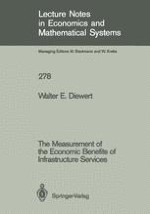This research was supported by the World Bank and the Social Sciences and Humanities R~search Council of Canada. Neither institution is responsible for the views expressed in this paper. The author is indebted to V. Corbo, A. Haymer, Y. Kanemoto, K. Lee, K. Mera, Hal Varian and A. Walters for helpful comments and to Elizabeth Lambert, Shehnaz Motani', and Jeanette Leigh Paisley for excellent typing services. I would like to dedicate this book to my wife, Virginia. TABLE OF CONTENTS 1. Introduction . . . •. . ••. . •. ••. •••. . . . •. . . . . •. •. . . •. . . •. •. •. . •. . . •. ••. • 2. A Simple Producer Benefit Measure . . ••. •••. ••••. •••••••••••. ••••••. • 8 3. Willingness to P~v Functions and Marginal Cost Functions ••••••••••• 15 4. Approximate Benefit Measures 30 5. Problems with the Producer Benefit Measure ••••••••••••• ! ••••••••••• 41 5. 1. Static versus Dynamic Benefit Measures ••••••••••••••••••• 41 5. 2. The Problem of Endogenous Prices for Local Goons ••••••••• 48 5. 3. The Neglect of Consumer Benefits' ••••••••••••••••••••••••• 56 6. Alternative Approaches to Benefit Measurement •••••••••••••••••••••• 70 6. 1. The Questionnaire or Sample Survey Approach •••••••••••••• 70 6. 2. Ex Post Accounting Approaches •••••••••••••••••••••••••••• 72 6. 3. Engineering and Mathematical Programming Approaches •••••• 74 6. 4. The Applied General Equilibrium Modelling Approach ~ •••••• 75 6. 5. The Differential Approach •••••••••••••••••••••••••••••••• 77 6. 6. The Econometric Approach . . •••••••••. •. ••••••. •••••••••. •• 79 7.
